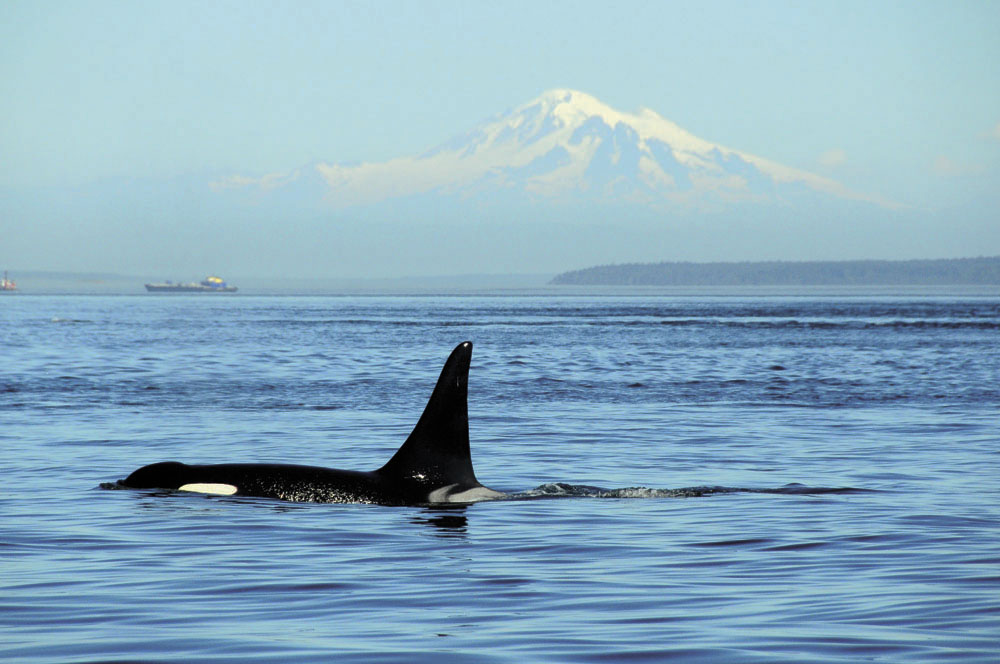While protecting Southern Resident orcas will require a variety of tools and approaches, Washington State Ferries plans to contribute by bringing tech out on the water.
One of the newest tools is an online system through WSF that exchanges real-time information about whales in the Salish Sea.
Kevin Bartoy, environmental stewardship and sustainability program manager at WSF, said the agency can feed data from a public whale sighting app (Whale Report App) into the Whale Report Alert System. This alert and reporting system will give commercial mariners alerts about a whale’s location in real time. Then, marine operators can either minimize the vessel’s noise or avoid collision with marine mammals by changing course.
“It’s something that will become more robust over time as we get more of that commercial maritime sector reporting in,” Bartoy said. “The more information we have coming in that’s verified, the better situational awareness we have on the water. We can be a leader that other people will follow.”
The Whale Report Alert System is only available to commercial mariners. The operation center sends the vessel alerts and the captain can make a decision from there.
“We thought, ‘We can do something quick and more immediate for the whales — let’s use this alert system. This is a way to more actively manage our noise as we move forward to create quieter vessels.” -Kevin Bartoy
The tool is just one part of a long-term strategy to address how underwater noise affects marine mammals. Minimizing vessel noise is one recommendation that came out of the Southern Resident Orca Task Force because orcas need a lot of room to communicate and hunt (through echo location) with minimized disruptions.
Gov. Jay Inslee signed legislation in the 2019 session that implements key recommendations from the task force, which developed a long-term plan for recovering orcas.
Their recommendations included:
· Increasing the abundance of Chinook salmon.
· Decreasing disturbance, noise and other risks posed by vessel traffic.
· Reducing exposure to toxic pollutants — for orcas and their prey.
· Ensuring adequate funding, information and accountability measures are in place to support effective recovery efforts moving forward.
The task force set an initial target of increasing the population to 84 orcas over the next decade. Inslee also issued an executive order in March 2018 that directed state agencies to take immediate actions to help the struggling orca population and establish the task force.
Bartoy said the alert system can stand in as a short-term solution for decreasing vessel impacts while various groups work to find a more long-term solution.
One WSF-led study currently in the works could help the fleet further decrease the underwater noise it produces.
In the study, WSF researchers use an underwater microphone to record the noise of vessels that pass above. Researchers can take that data to create a noise footprint and know what vessels sound like at certain speeds. This data could drive potential engineering changes in the future as well.
Once WSF gets verified data on a whale’s location, they can notify their vessels in the vicinity about a whale’s presence. The notification could include what kind of whale is nearby, the longitude and latitude, how many whales and where they’re headed. The captain then has two options. One, they can either slow the vessel down to shrink the noise footprint. Or two, the captain can change course and move away from the whale’s location.
“We thought, ‘We can do something quick and more immediate for the whales — let’s use this alert system,’” Bartoy said. “This is a way to more actively manage our noise as we move forward to create quieter vessels.”
WSF spent the better part of a year implementing the Whale Report Alert System, collaborating with British Columbia to bring it south of the border since it was already active in Canadian waters. Ocean Wise worked on the system and Vancouver Fraser Port Authority and Prince Rupert Port authority funded it.
WSF’s goal is to get the five primary commercial operators in Puget Sound on board with using the public Whale Report App.
The main commercial operators include the state ferry system, the American Waterways Operators (who represent the tug and tow industry), Puget Sound Pilots, and Kitsap Fast Ferries. These make up more than 85 percent of the transits tracked in Puget Sound.
– WA Governor’s Office






